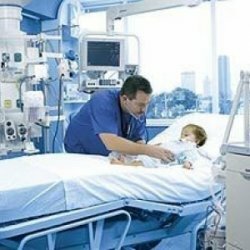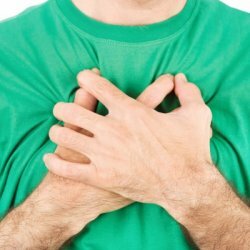Severe community-acquired pneumonia
 Community-acquired pneumonia is considered the most common infectious disease. If we talk about figures, in Russia for every 1000 people, 10-15 people fall ill every year, in Europe, for every 1000, 2-15 people a year fall ill. The indicator of the disease significantly increases among the elderly, especially among people over seventy years old - it is 68-114 people a year. According to statistics, for every hundred sick people, about 20% need inpatient treatment, and 10% need treatment in the intensive care unit( ICU).In the US, about 5-6 million people fall ill with severe community-acquired pneumonia every year, 20% of whom need urgent hospitalization, so this is a very common infection.
Community-acquired pneumonia is considered the most common infectious disease. If we talk about figures, in Russia for every 1000 people, 10-15 people fall ill every year, in Europe, for every 1000, 2-15 people a year fall ill. The indicator of the disease significantly increases among the elderly, especially among people over seventy years old - it is 68-114 people a year. According to statistics, for every hundred sick people, about 20% need inpatient treatment, and 10% need treatment in the intensive care unit( ICU).In the US, about 5-6 million people fall ill with severe community-acquired pneumonia every year, 20% of whom need urgent hospitalization, so this is a very common infection.
Pneumonia and its forms
Depending on the conditions where pneumonia occurs, it is divided into four types:
- community-acquired pneumonia - a disease that is purchased outside the walls of hospitals;
- hospital pneumonia - is purchased in medical institutions;
- aspiration;
- pneumonia, which affects people with HIV.
There is also a classification of this disease by severity. Community-acquired pneumonia is divided into three subspecies:
- when hospitalization is not needed. Lethality, as a rule, is 1-5%;
- when hospitalization in hospital is necessary. Mortality can reach 12%;
- when hospitalization is needed in the intensive care unit. Mortality with this form of pneumonia reaches 40%.
Unfortunately, severe community-acquired pneumonia often leads to death, so its treatment should be performed in the ICU.
Symptoms of severe community-acquired therapy
There are only a few symptoms that are decisive for the ill to be sent to the ICU:
- septic shock, severe sepsis;
- respiratory failure;
- pulmonary infiltrates are common in the chest image.
Typically, for the establishment of an accurate diagnosis and treatment, the following tests are submitted: general and biochemical blood test, sputum culture, hemoculture study, X-ray, Gram staining. For those patients who are in the ICU, a gas analysis of the arterial blood is also performed.
Determining the severity and risk of death in this disease
In order to determine the optimal place of therapy, how to transport the patient, the tactics of treatment, a criterion such as the severity of the condition is needed. For this purpose, scales for assessing severity and forecasts exist. The most common scale Pneumonia Severity Index( PSI), which is used since 1997.According to PSI, the main criteria for the severity of the disease are:
- the age of the patient;
- changes in vital parameters;
- associated pathology.
In order to assess the severity of community-acquired pneumonia on a PSI scale, radiography and a gas blood test are necessary. The more points the patient picks up, the worse the prognosis. In total, according to this method, there are five risk groups, and those who fall into the fifth, must be immediately hospitalized in the ICU.
A new PS-CURXO-80 scale was recently introduced, which is based on eight indicators, and is considered more accurate.
Microbiological pathogens of severe community-acquired pneumonia
Unfortunately, it is only possible to identify a microbiological pathogen in 40-60% of cases. The most common causative agent of severe community-acquired pneumonia is Streptococcus pneumoniae. According to statistics, it accounts for about 22% of severe community-acquired pneumonia. If we talk about viral infections, then only in 5% they become pneumonia. To such viral infections primarily include influenza, parainfluenza, respiratory syncytial virus, adenovirus.
Severe Pneumonia Recognition
The most common symptoms of this disease: fever, cough, shortness of breath, chills, chest pain, hemoptysis, sputum production. There are symptoms that are less common, but they should also be paid attention: weakness, diarrhea, headache, nausea, vomiting, myalgia, syncope.
In the elderly, the symptoms are somewhat different, especially after 75 years. In 40% of elderly patients there is no cough, and 15% have no fever. Often in the elderly, the main symptoms are tachycardia, tachypnea, confused consciousness.
The basic standard for the detection of pneumonia is still considered radiography. However, it is not always possible in this way to diagnose pneumonia 100%.A negative result in patients with pneumonia on the X-ray can be obtained in such cases:
- during dehydration;
- in the early stages of the disease;
- for neutropenia.
In such cases, it makes sense to conduct CT of the chest.
Treatment of
The main key to success in treatment will be the rapid onset of proper antibiotic therapy. Ideally, the treatment should be selected within one hour after the patient arrives at the ICU, and within two hours of admission to the hospital.
The antimicrobial preparation is started to be used until the results of the tests for the detection of microorganisms. So come for several reasons:
- in most cases, to identify the microorganism is not possible even with the newest types of analyzes;
- any delay in treatment threatens the risk of complications;
- most often the result of radiography, evaluation of the clinical picture allows you to choose the right treatment.
The result of antibiotic therapy depends on the patient's immune system, the causative pathogen, the severity of pneumonia. A positive reaction to therapy should occur within 1-3 days. The main criteria for the effectiveness of treatment: a decrease in temperature, the absence of respiratory failure. In the process of treatment, it is necessary to conduct research that will help determine the appropriateness of therapy: a general blood test, a biochemical blood test, a study of blood gases, radiography, which is performed after 2-3 weeks. In the case where the treatment is ineffective within 72 hours, the antibacterial drug is replaced. As a rule, treatment of severe community-acquired pneumonia lasts from 14 to 21 days.
In the case of severe community-acquired pneumonia, prevention from complications plays an enormous role. The main drugs for community-acquired pneumonia remain the third generation cephalosporins in combination with macrolides, such as erythromycin, spiramycin, clarithromycin. With this disease, it is contraindicated to use antihistamines, NSAIDs, nystatin.
Forecast for severe community-acquired pneumonia
The mortality of patients with hospitalization in the ICU is rather high - 22-54%.According to recent studies, the main parameters that characterize the unfavorable prognosis are as follows:
- elderly age, over 70;
- bacteremia;
- holding ventilation;
- sepsis;
- bilateral pneumonia localization;
- inefficiency of initial treatment;
- the need for intropic support;
- infection of P. aeruginosa.



